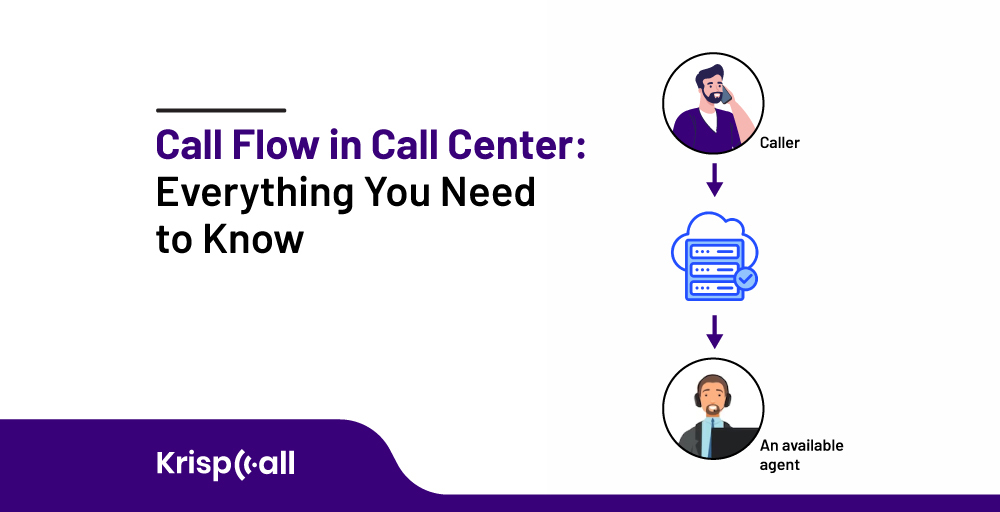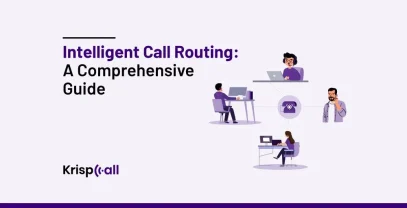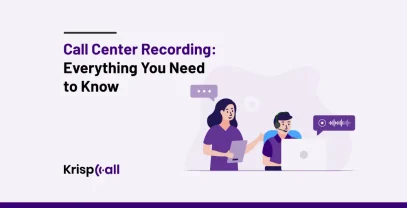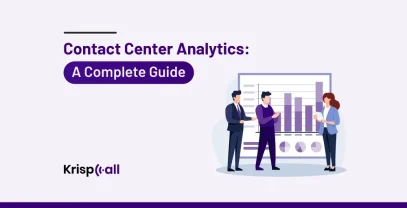Do you want to get better at handling calls for your business? 🤔
Call flow in call center is the initial steps that help your customers engage with you.
Customers don’t like to wait in phone lines or be put on hold. They prefer to have their problems settled in the first call itself. But it is hard to find in the real scenario.
Don’t worry. By strategically implementing the call flow in the call center 📈, your business is on the right path to achieving customer satisfaction and efficiency.
Let’s learn more about call flow in the call center, how it works, its benefits, ways to optimize call flow, and many more in this article.
💡 Key Highlights
- Call Flow is a road map for agents to handle and distribute incoming calls and provide speedy solutions as quickly as possible.
- Call Flow contributes to first-call resolution, reduced operational costs, and improved agent productivity and satisfaction.
- Types of Call Flow are Sequential Call Flow, Time-based Call Flow, Direct Dial Call Flow, Skill-based Call Flow and Rotational Call Flow.
What is Call flow in a Call Center?
Call Flow in a call center is a road map for agents to handle and distribute incoming calls coming from customers and provide speedy solutions as quickly as possible.
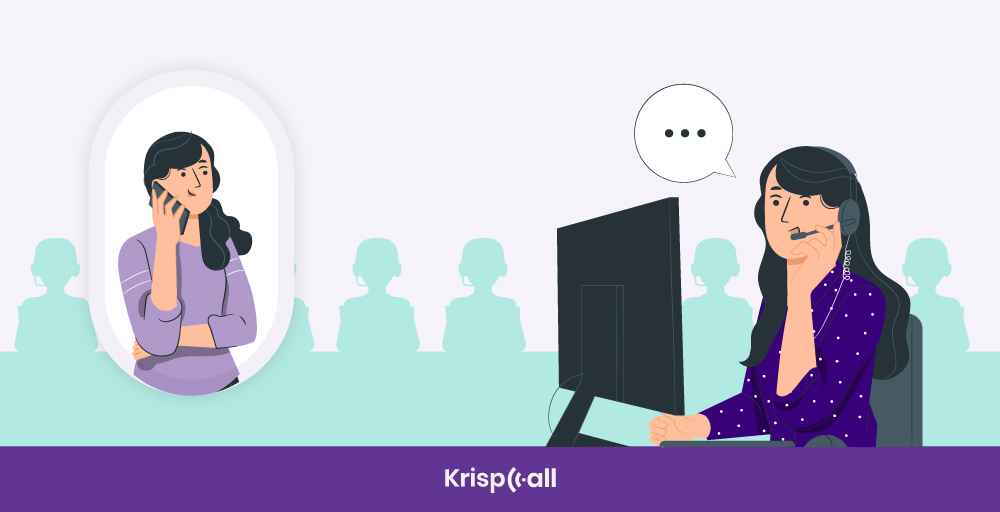
Call Flow provides the information i.e. prompts to guide the customer to take the right actions from the beginning of the call to the point when the customer hangs the phone.
It includes information such as initial greetings👋, asking customers what they are having issues, actions to take, and leading the call to the right person in charge.
Call Flows are mainly used in contact centers to reduce call hold times, improve the inbound call management systems, enhance call management through automated routing, and boost customer experience🌟.
In addition, call flows are also responsible for managing problems like busy lines, disconnected or redirected calls, etc.
Customer Service Call Flow Examples
Here’s how customer support call flow is structured:
- Warm and Personalized Greeting: “Hello, <customer name>! We appreciate your call to ABC.”
- Identify the Purpose of the Call: “How may I assist you today?”
- Verify Identity: “To ensure security, could you please confirm your <identifier>?”
- Confirm the Issue: “I understand you are reaching out for <problem summary>. Is that correct?”
- Express Support and Understanding: “I can imagine that dealing with this situation might make you feel <emotion>. If I were in your position, I would likely feel the same way.”
- Provide a Solution: “Let’s work on resolving this together. Here’s what we can do: <solution>.”
- Offer Further Assistance: “Is there anything else I can help you with today?”
- Closing Remark: “Thank you for choosing ABC. Have a nice day!”
How Does a Call Flow Work in a Call Center?🤷
There are several steps in every call flow. However, the call flow should have steps or processes that can guide customer satisfaction and make an excellent customer experience.

Step 1: Incoming Call
The first step starts after the customer calls the call center. It triggers the call flow in a call center. The call could be from your local phone number, toll-free number, or even a custom-made vanity phone number.
The call is usually answered by an automated system like Interactive Voice Response (IVR). This system can provide basic information, direct the calls based on the inputs of the customer, and also place the customer in a waiting line for available agents.
Step 2: Call Routing
The call is directed or routed to the appropriate agent or department based on the nature of the call or the choice made by the customer in the IVR.
Call Routing helps the customer reach the desired agents who can successfully solve the problem or inquiries of the customer.
Step 3: Agent Interaction
After the call routing process, the customer communicates with the right agent. In this step, the agent greets the customer and verifies the customer’s identity for security purposes🔐.
The agent then listens to the customer’s issues fully and asks necessary questions for clarification. The agent also gathers additional information to assist the customer.
Step 4: Problem Resolution
This step is crucial as the problems and inquiries of customers are addressed here. The agents provide the step-wise solution to the difficulties of the customers.
All the required assistance and information are provided by the agents. If the agent cannot resolve the issues, it may be passed on to a supervisor or an expert.
Step 5: Closure and Follow-up
After resolving the issues of the customer, the agents check with the customer to make sure their problem is completely solved. The call is then concluded and the call center can assist customers further by making them fill satisfactory survey.
The agents also arrange follow-up action if needed. Follow-up example: for sending email confirmation or additional information.
What are the types of Call Flow in a call center?
There are various types of call flow in a call center. They are all designed to address various requirements and situations.
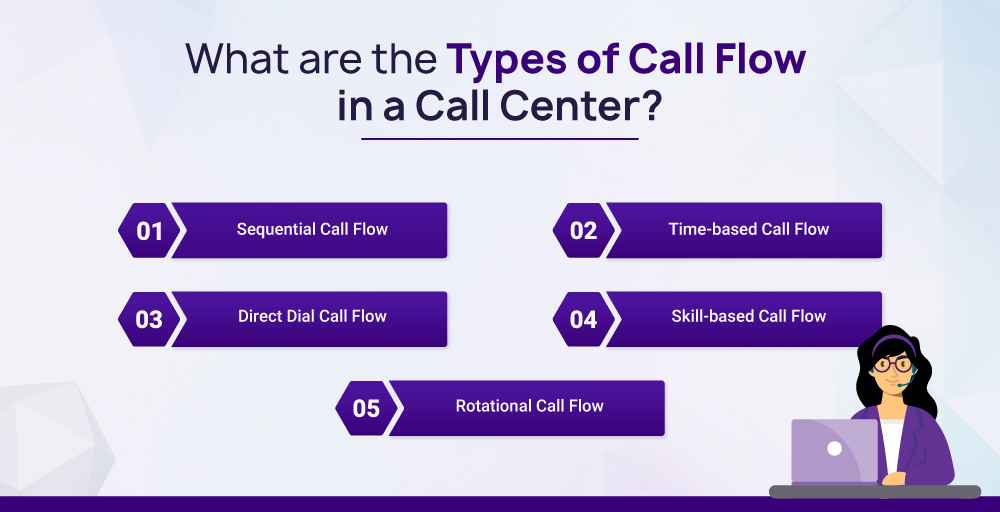
1. Sequential Call Flow
Sequential Call Flow is a simple call routing method where phone calls are directed in linear or sequential order. The calls are distributed to agents one at a time based on their availability. It follows a specific order.
Example:
- If you call for Sales, your call goes directly to a sales team member.
- If you call for Support, your call goes straight to a support team member.
Sequential Call Flow is straightforward. This type of call flow is suitable for small businesses with low call volumes and minimal management.
2. Time-based Call Flow
Time-based Call Flow is a call routing method where the phone calls are handled and routed to different agents or departments depending on the time of day or specific days of the week.
Example:
- For instance, let’s say you provide customer support 24/7, and you have offices in both Chicago and London. If someone calls at 3:45 a.m. Chicago time⏰, instead of trying to connect them to agents in Chicago, the call is automatically routed to your London office, where it’s 9:45 a.m. and your team is available.
- Alternatively, if your business doesn’t operate outside regular hours, and someone calls after closing time🌙, you can choose to send a message saying you are closed and let callers know when you will be open again.
3. Direct Dial Call Flow
Direct Dial Call Flow is a call routing method where the phone calls are handled efficiently by allowing callers who already know who they want to talk to dial specific extensions of desired agents or departments.
It helps to improve customer experience by avoiding the need to navigate through all options causing unnecessary delays.
Example:
- A customer service call center🏢 has direct extension numbers for specific support teams, such as technical support or account inquiries.
- When a customer calls, they can dial the extension and directly solve their problems. For example, “Press 1 for Technical Support” or “Press 2 for Account Help.”
- This allows customers to directly connect with the appropriate support team without going through a lengthy process and get quick output⚡.
4. Skill-based Call Flow
Skill-based Call Flow is a call routing method where the phone calls from customers are routed to agents who have the call center skills that are required to address customers’ difficulties.
Example: When a customer calls, they are offered multiple options they can choose from based on their difficulties, and on clicking the desired option, their calls are skillfully routed to the right agents who can solve their problem🛠️.
5. Rotational Call Flow
Rotational Call Flow is a call routing method where the phone calls from customers are directed among available agents in a rotating manner. This approach evenly distributes the work among all the agents and is very efficient in managing high call volumes.
For example: When a customer calls, their calls are passed around to the available agents in the call center in turnwise. In this approach, every agent gets a fair number of calls which helps to keep things on balance⚖️and manage a high number of calls.
What is the Importance of Call Flow in Call Centers?
Call Flow is important in call centers to address the problems of customers, direct them to the right agents, and ensure good customer experience😊.
It helps to manage high call volumes, establish a consistent communication strategy, and eliminate customer frustrations like multiple call transfers, long hold times, and connecting to unprepared agents.
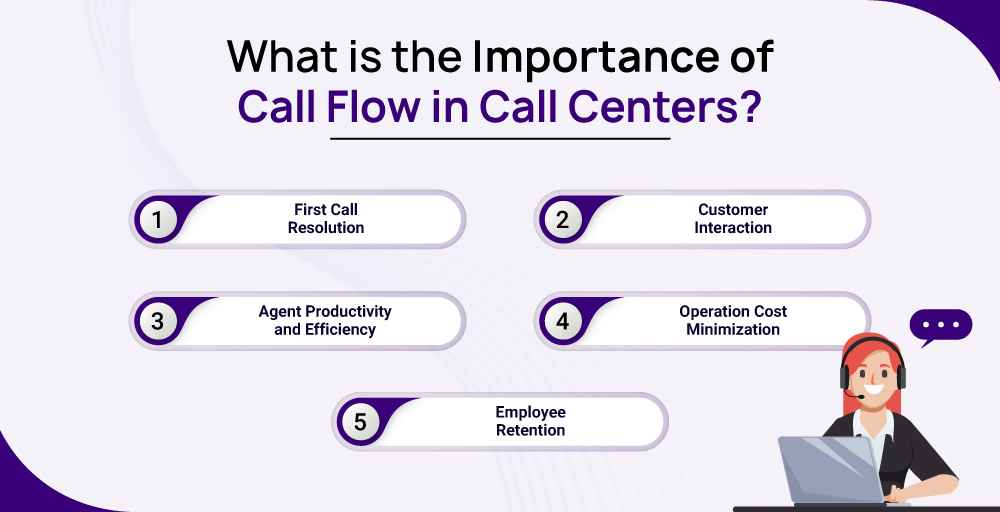
1. First Call Resolution🎯
First Call Resolution is the customer service metric that measures the performance of the call center in solving customers’ difficulties on the first call. It eliminates the need for follow-up contacts. Strategic Call Center Call Flow helps to achieve first-call resolution.
It is considered an important metric as it reduces unnecessary delays that could come when the calls are not addressed properly. When the problem is solved on the first call, the customer is satisfied as they don’t have to wait long times and go through multiple calls.
2. Customer Interaction👥
Call Flows lead to smooth customer interaction leading to customer satisfaction and good customer experience🤗. The customer interacts with the right agents and their problems are solved in a short period.
Healthy customer interaction, shorter wait times, quick resolution, happy agents, and being addressed to the right customers, all lead to better customer service.
3. Agent Productivity and Efficiency📊
The productivity and efficiency of the agents increase when they use call flows in the call center. They can resolve problems faster🚀 and help to uplift customer experience. It helps them how to do their job without confusion and reduces stress.
Agents know what they should do in different situations and guide the interaction among customers smoothly. Also, the smart management of call flows helps the right agent having the right skill go after the task to handle the customer’s inquiries.
4. Operation Cost Minimization💸
Effective call flows help to reduce the operation cost and save a lot of money. It encourages the call center to use digital technology. It leads to a switch to cloud-based phone systems🌐, which are twice as cheap to operate.
Also, it encourages to use of automated workflows that help in achieving better results and making fewer mistakes. This will lead to a boost in the profit of the business.
5. Employee Retention🔄
Call flows help to guide the employees/agents to make smart decisions. They are taught what to say in desired circumstances. When employees become confident about their work, they are more likely to stay in their jobs💼.
11 Ways to Optimize Call Flow Processes in the Call Center
Optimized Call Flow Processes in the call center help to improve customer satisfaction, reduce cost, provide better quality services, and achieve competitive advantages.
Since optimizing call flow processes has several benefits, you should know the ways to optimize call flow processes.
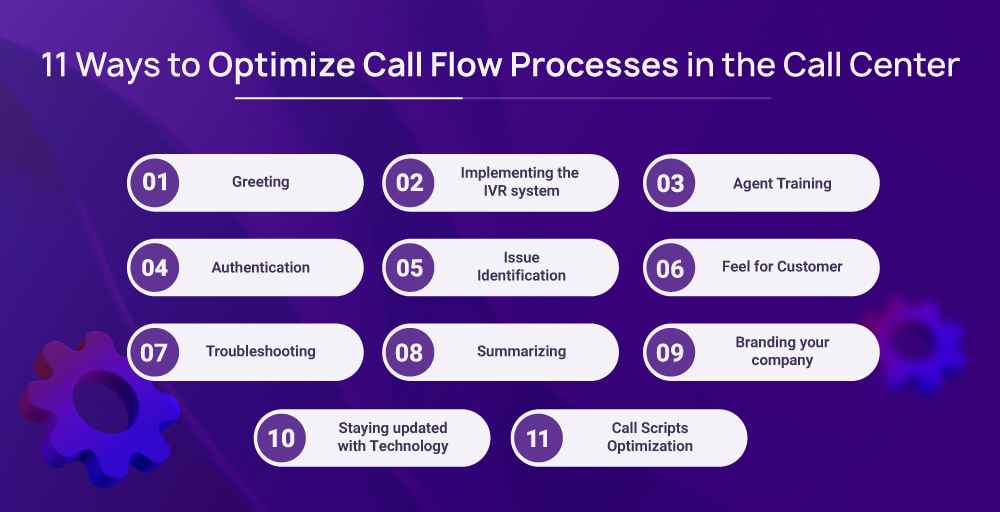
Luckily, the below factors help to optimize the call flow in the call center.
1. Greeting🤝
Greeting is fundamental to starting a positive interaction with customers. You need to start with simple but impactful greetings. It is very important to address the caller with a welcoming, warm, and open attitude.
The agent should answer the call with energy and enthusiasm. Even if the clients are in a bad mood, the agent must speak politely. The most important thing, agents must introduce themselves and disclose the company name before assisting.
2. Implementing the IVR system💡
The Interactive Voice Response (IVR) system is an automated system for handling call flows in call centers for quicker interaction with customers and direct calls to appropriate agents or supervisors.
IVR system optimizes the call flow by handling large call volumes coming at the same time, can provide 24/7 support, efficiently route to the right department, and reduce the need for large staff to handle basic queries of the customers.
3. Agent Training🌟
One of the ways to optimize call flow is by giving training to the agent in the call center. Many different scenarios can arise at the time of customer interaction.
The agent should be well-prepared to handle different customer demands and problems. If the agent is unprepared then he/she might lose confidence and can negatively impact the brand of the whole company.
4. Authentication🔒
The agent must verify the caller’s identity. This will help to save the company precious time and also to find scammers. Not only that, it gives customers a good identity of your company that your company is serious about sensitive information.
The agent should ask the client’s personal information such as their date of birth, phone number, and previous purchase to identify the callers.
5. Issue Identification🔍
After the caller’s identity is checked, the agent should focus on addressing the reason for the client to call. This is when the call may be transmitted to the specialist.
It is crucial for the agents who initially answer incoming calls from customers to identify which department or specialist should handle the call correctly. If the call is sent to the wrong agent or department, it can lead to a negative experience for the customer. Also, it can damage the brand of the company.
6. Feel for Customer💖
When the customer issue is identified, the agent should take the issue seriously and be eager to help the client. The customer shouldn’t feel ignored or unimportant once the problem is recognized. If this phase is misguided, the overall customer feedback is negatively affected.
7. Troubleshooting🛠️
After the issue has been acknowledged and addressed properly, the agent’s responsibility is to find the right solution. The agent may have to solve the problem by themselves or transfer the inquiries to a design specialist. This process might be solved immediately or take some time based on the nature of the problem.
8. Summarizing📋
Summarizing comes into play after the solution is presented by the agent. The agent summarized what the difficulties were and how the difficulties were solved. The agent should remember to ask if there is any further help the client needs.
9. Branding your company🏢
At the final stage, the agent should not rush to end the call. The agent should stay calm and make sure to address the company name again. The agent can thank the customer for their time and give them some time to share their positive feeling about the interaction.
10. Staying updated with Technology💻
High-quality customer service matters in the call center. The organization must stay updated with the software and technology. It helps to achieve efficiency, improve customer experience, and protect against spam and cyber threats.
The call center can use advanced technology like customer relationship management (CRM) systems, workforce management tools, IVR systems, and automatic call distributors (ACD) software.
11. Call Scripts Optimization✍️
Call Scripts are written scripts that help agents to smoothly communicate and interact with customers. There should not be the same call scripts for years in a call center.
The call scripts should be continuously refined and should be effective and efficient. There should be regular reviews and updates on call scripts and the script should focus on improving customer experience.
This helps to improve agent performance and also plays a vital role in improving customer satisfaction.
KrispCall: A Leading Solution for Call Flow Management
KrispCall is a cloud-based phone system that provides various features for business telephony. It includes effective tools like call forwarding, call recording, global calling, text messaging, voice mail, advanced IVR features, and call analytics.
It offers solutions like inbound call center software and outbound call center software, especially for call centers to maintain their call flow for high productivity.
Also, it provides facilities for auto dialer software, cloud contact center solutions, virtual call center software, automatic call distribution software, and VoIP call center software.
The virtual and cloud-based nature of KrispCall helps to adapt to various call center setups which improves efficiency and customer handling🚀.
Conclusion
Strategic optimized Call Flow in the call center is crucial for improving customer experience and making customers feel satisfied😊.
Although there is no fixed formula for success, staying current with trends, continuously innovating, regularly training and upgrading skills, and monitoring performance can greatly enhance your call flow effectiveness.
Luckily, Your contact center can easily maintain call flow and upgrade the efficiency and output with the help of tools like KrispCall. Get connected with us to know how we can improve and optimize the call flow process 🚀in your call center.
FAQs
What is the main purpose of call flow in a call center?
The main purpose of call flow in a call center is to manage incoming and outgoing calls effectively and direct the inbound calls to the right department or supervisors. This helps in providing customer satisfaction and improving customer experience.
What are the key components of call flow in a call center?
Key Components of Call flow in a call center are:
- Initial Welcome Greeting
- Agent Training
- Authentication and Issue Identification
- IVR and Call Routing
- Escalation
- Post-Call Documentation
What tools can improve call center call flows?
The tools that can improve call center call flows are:
- Interactive Voice Response (IVR)
- Call Management System
- Employee enablement Software
- Knowledge Base or Document Library
- Automatic Call Distributor (ACD)
What is the role of IVR in call flow?
The role of IVR in call flow is to handle large call volumes arriving simultaneously, efficiently routing to the right department, providing 24/7 support, and reducing the need for large staff to handle the problems of the clients.

